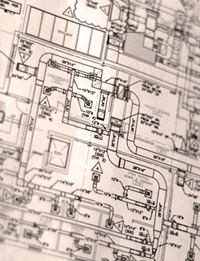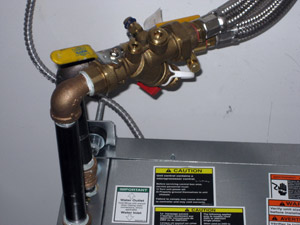Efficient air-handling systems? Here’s one simple strategy that I advocate for on every project I can – direct drive fans. Why? No belt losses (energy) and less maintenance (money).
As a building commissioning provider, I’ve only seen one project team take me up on that suggestion. One. Engineers most often note that the equipment simply isn’t available with direct drive fans. This may be true for an “off the shelf” piece of equipment, but nearly every air handler I see is custom made, to one extent or another. Tell your rep you want a direct drive fan and I bet he or she will find one for you.
Why forgo belts?
First, belts waste energy. Typical V-belt losses vary between 4 and 8% depending on motor size and speed. AMCA 203-90 addresses this. AAON® cited the AMCA 203 data in The Cost of Belt Drives. (pdf) Even 6% of the energy to run a 10,000 CFM air handler is roughly 2/3 HP. Doesn’t sound like much but combined over a handful of units and applied over their life expectancy and it adds up. Another consideration is that an under-tightened belt will slip, further increasing the belt loss, by as much as an additional 4-6%.
Second, belts cost money to buy and maintain. Here’s a photo of a recent project I was involved with. Roughly 30 different belts! Someone has to inventory all those belts and maintain all those systems - time and money that could be spent elsewhere or saved. AAON shows a $20,000 maintenance cost over the 17-year life of a 3-HP rooftop unit. Even if you take their economics with a grain of salt, you can’t argue that’s a lot of money – FOR ONE UNIT!
What’s the solution?
Direct drive fans are the solution, but you already knew I was going to say that. What if your fan selection isn’t a standard motor speed? No problem - put a variable frequency drive (VFD) on it and set the max speed you need in the drive. There’s no problem running a motor at, say, 70 Hz either as long as the motor is sized for the expected amperage. Most systems today utilize variable speed control anyway so the drive is already there! Got a fan selection that’s 1000 RPM? Use a 1200 RPM motor with a drive set to a max output of 50Hz. 2000 RPM? 1800 RPM motor with a drive set to a max output of 67Hz etc.
Want an added incentive? The variable frequency drive boosts the utility side power factor to near unity. Larger customers get charged for low power factors (PF). The charges and thresholds differ by utility, but they’re there. How? Basically, the motor PF is separated from the utility via the drive’s DC bus, but that’s another topic.
There are always other things to consider too. Drives with bypasses make the under speeding of a motor tricky. In bypass mode you could easily trip the over-current protection. For over-sped motors you don’t get the design CFM in bypass mode, but the bypass should only be temporary. Drives with bypasses are not that common, except in critical applications, so I consider them an exception to the rule.
In short, with a little foresight, you can apply direct drive fans in the majority of applications with little or no added cost and the benefit of increased efficiency and reduced maintenance costs. Give it a shot!
Related articles
- Variable Frequency Drive (Canada Natural Resources)
- Servicing V-Belts and Drive Pulleys (jcijcp.wordpress.com)



